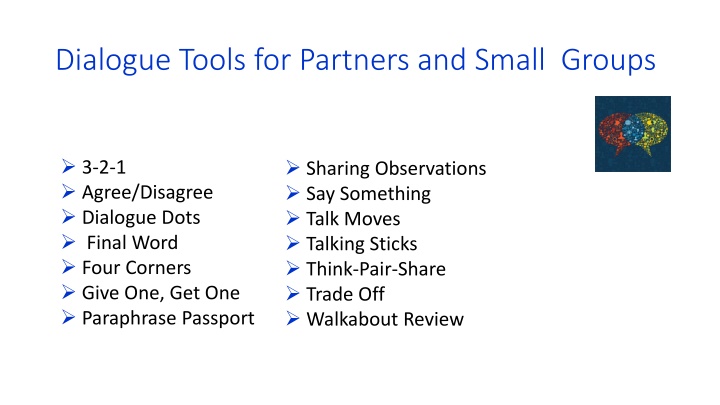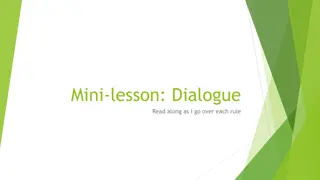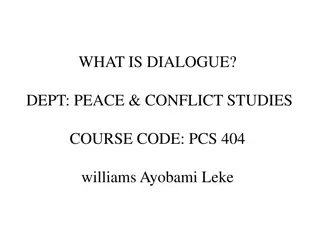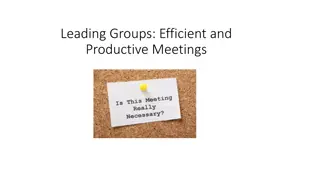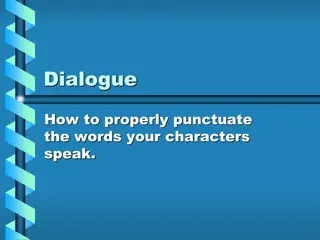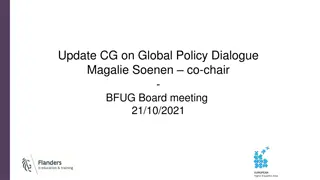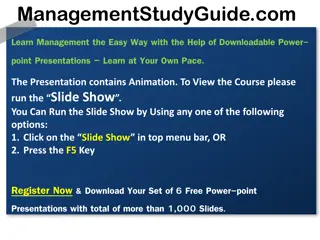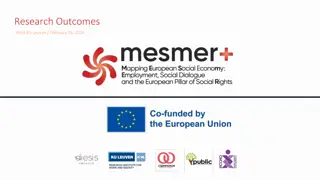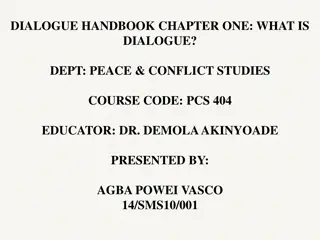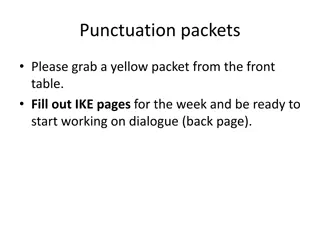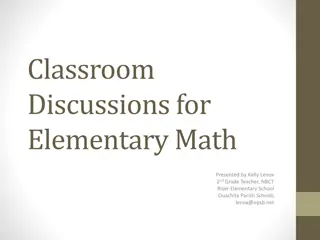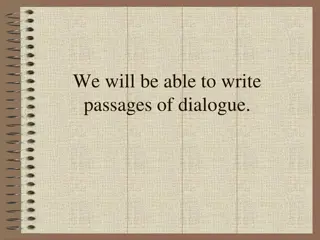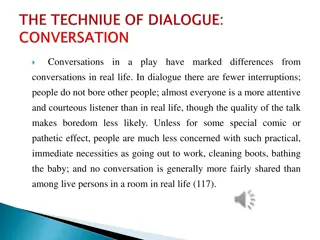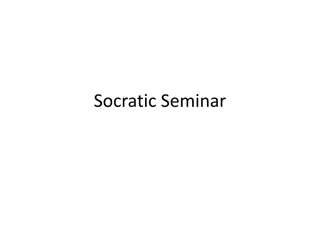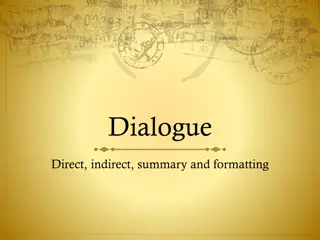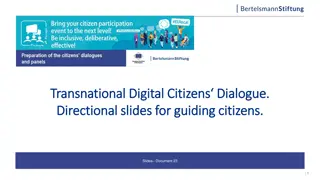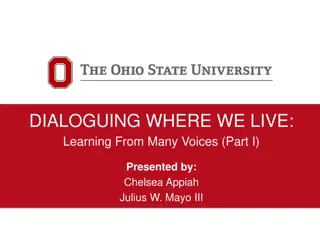Productive Dialogue Techniques for Effective Group Discussions
Enhance group discussions with various productive dialogue tools like Agree/Disagree, Sharing Observations, Talk Moves, Final Word, and Four Corners. These techniques encourage active participation, critical thinking, and collaboration among group members, leading to meaningful conversations and consensus building.
Uploaded on Oct 11, 2024 | 0 Views
Download Presentation

Please find below an Image/Link to download the presentation.
The content on the website is provided AS IS for your information and personal use only. It may not be sold, licensed, or shared on other websites without obtaining consent from the author.If you encounter any issues during the download, it is possible that the publisher has removed the file from their server.
You are allowed to download the files provided on this website for personal or commercial use, subject to the condition that they are used lawfully. All files are the property of their respective owners.
The content on the website is provided AS IS for your information and personal use only. It may not be sold, licensed, or shared on other websites without obtaining consent from the author.
E N D
Presentation Transcript
Dialogue Tools for Partners and Small Groups 3-2-1 Agree/Disagree Dialogue Dots Final Word Four Corners Give One, Get One Paraphrase Passport Sharing Observations Say Something Talk Moves Talking Sticks Think-Pair-Share Trade Off Walkabout Review
Productive Dialogue: Sharing Observations The first person uses this sentence frame to tell what he or she is thinking about the phenomenon: I noticed that ______________ Go around the circle with each person getting a chance to talk. Be prepared to share the ideas of your group with the whole class.
Productive Dialogue: Talk Moves Adding to what _____________ says, I think ________________. I agree/disagree because _______________. I like ________________ idea and I would like to add __________. Why don t we try ____________? Why do you think that __________? Can you say that in another way? How is ________ like _______?
Productive Dialogue: Agree/Disagree Your instructor will provide the claims, either on paper or projected, that will be debated. Example: The stars are always in the same place in the sky. Record your stance for each question. Taking turns with each statement, expresses agreement or disagreement to your group and explain your reasoning. For each statement, your group should discuss the stance, and focus on those statements that not all members agreed on. Try to come to consensus, based on evidence. For those statements on which you agree, identify why you disagree on them.
Productive Dialogue: Final Word One person states an idea. The next person comments/responds to this idea. Go around the table until everyone has a turn. The first person gets the final word. Repeat until everyone has shared their idea. Try to address each of the questions in about three rounds. It s okay to combine questions. The key is to have a professional, robust dialogue.
Productive Dialogue: Four Corners In each corner of the room are categories of stances: strongly agree, agree, disagree and strongly disagree. For the stated prompt, choose the corner most aligned with your thinking. Discuss your stance with your group, and list four or more reasons why you all picked that stance. Re-sort into groups that have at least two difference stances, and explain your stance and why you hold it. Summarize the discussions you ve had and your current stance on the issue, and whether and why your viewpoint has changed.
Productive Dialogue: Paraphrase Passport One person begins by making a comment related to the topic. The next person to speak paraphrases the first comment before stating his or her comment. After paraphrasing the prior comment, the group member adds a new comment. Repeat the process around the group, until all have shared.
Productive Dialogue: Say Something In response to a prompt, one person talks at a time, and the chance to say something proceeds around the group until all have had an opportunity. Students can comment by making an observation, a comment, asking for clarification, making a connection, making an inference, or asking a question.
Productive Dialogue: Talking Sticks Designate a pencil or other object as a talking stick, and put it in the center of the table. To make a comment, a student picks up the talking stick. When that student is finished, he or she puts the stick back in the middle and cannot pick it up again until everyone else has had a chance to comment.
Productive Dialogue: Trade-off In pairs, students think quietly on the prompt for a minute. Partner A speaks for 20 seconds, and Partner B listens. Partner B paraphrases for 10 seconds what s/he heard Partner A saying. Partner B speaks for 20 seconds while Partner A listens. Partner A paraphrases for 10 seconds what s/he heard Partner B saying. Repeat the process, increasing the time to 30 seconds. Each partner summarizes or adds to the conversation for up to 45 seconds.
Productive Dialogue: Think-Pair-Share Each student records his or her thoughts, shares them in turn with a partner, and records what is heard from the partner. After discussion, each records the understanding resulting from the dialogue.
Productive Dialogue: Walkabout Students engage in an in-depth conversation about a problem, concept or model. With direction from the instructor, students create graphic organizers for tracking their thinking and conversation for both partners. Students rotate to other dialogue partners and repeat the process however many times it makes sense to do so. When rotations are complete, students write, diagram and/or dialogue in a group, about how their own understanding of the topic has changed.
Dialogue Tools Around Text Specific protocols for use with text Fishbowl Golden Thread Points of View The Four A s
Purposeful Reading: Fishbowl Students read a text about a controversial topic, that has two credible and legitimate sides to it. and take notes on pros on cons. Ideally, they are encouraged to read from both points of view from the beginning, and to be able to argue either side. Divide class into 2 groups, and assign a pro or con stance to each group. Half of each group then sits in the fishbowl and debates, using a talking stick protocol. Each student must provide reasoning for statements they give. The other half evaluate the content and process of their partner s participation Students switch roles and the second group goes into the fishbowl. Whole class debriefs about content and process
Productive Dialogue: Golden Thread Read the provided text. Review what you ve read and pick a golden line from the text that: raises questions for you confirms what you already believe makes you say, Ah Ha conflicts with your beliefs causes you to reconsider prior assumptions Each person then shares their golden line and why they chose it with their table group and discuss in small groups for 4 minutes.
Purposeful Reading: Points of View Choose a text that poses a problem will multiple sides. Identify 2-4 points of view for those who would have a stake a problem posed by a text(for instance, in a text about farming, a farmer, a consumer, a food retailer, and a food scientist could be possible choices.) Assign a Point of View Role to each person in a group. Spend 1 minute imagining how your assigned point of view would view the dilemma, then work to come to a resolution on this issue as a group. Each group presents your resolution to the class as a whole.
Purposeful Reading: Four As From the provided text, write down at least one of each of the following: What Assumptions does the author of the text hold? What do you Agree with in the text? What do you want to Argue with in the text? What parts of the text do you want to Aspire to? As a class or in small groups, using a small group taking-turns protocol, share the assumptions you identified. Continue with each of the remaining A s one at a time End the session with an open discussion framed around a question you have prepared, or one that comes up in the conversation.
